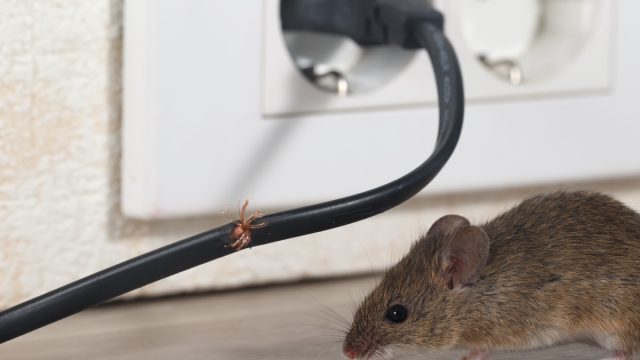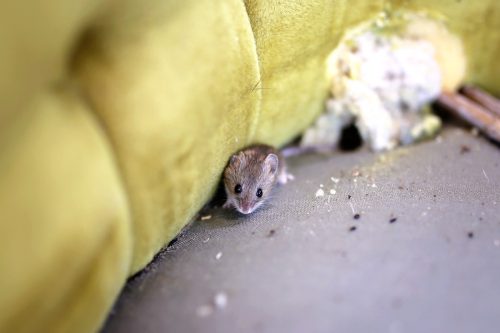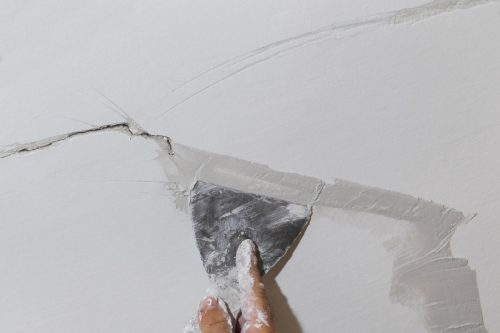The Strangest Places Mice Hide in Your Home—And How to Find Them

As the weather shifts, your home may become a nesting spot for pests, especially mice, even if you think your home is rodent-proof. “With the colder winter months coming, they are looking for a safe, warm spot to live, as well as sustenance,” says Brandon Thorsell, district manager for Critter Control of Toronto, who adds that they will chew on essentially any surface or material to get to a food source or shelter. The attic, the basement, or a well-stocked pantry are the more obvious spots they head, but mice can also end up in plenty of other places inside your home. Luckily, pest experts share where they could be camping out and how to find them. Keep reading to learn about the strangest places mice hide inside your home.
RELATED: 8 Plants Attracting Mice to Your Home.
1
Kitchen appliances

It’s more common than you’d think to see mice under the dishwasher, oven, or fridge. Those areas are typically nice and warm, and they’re also in close proximity to food sources.
Daniel Ledezma, SMART program lead at Anticimex Carolinas, explains that mice need to keep a certain body temperature to survive, and if they don’t, their fast metabolisms will eat up all their energy, causing them to look for more food.
“Take a quick look under the stove and behind a fridge to make sure there are no droppings and possible openings in the wall that will give them access to this area,” he says.
Georgios Likopoulos, pest control expert at Fantastic Services, notes they can also hide inside these appliances rather than just around them, so be on the lookout for chewed wires as well.
2
Furniture

Mice have no problem nesting in furniture, especially if it’s close to a heat source like a radiator, says Craig Sansig, service director at Viking Pest Control. Couches are even more likely to get some visitors because they have crevices that are easily accessible.
In addition to providing heat, furniture often has a lot of crumbs inside. “Remember to look under furniture and remove any food particles that might attract rodents to live under or sometimes inside your favorite couch,” says Ledezma.
RELATED: 8 Foods That Are Attracting Mice Inside Your Home.
3
Roofs

Mice have an advantage when it comes to looking for food and shelter because they are not afraid of heights. “They can be found easily scaling the exterior of buildings to access the roofline where they gain access to attics,” says Sansig.
More often than not, they will use pipes or wires to gain access to other areas of the home. “Small vents or openings in the roof can allow mice to access attics,” adds Likopoulos.
Check for signs of infestation, such as nests, droppings, and gnawed insulation.
4
Drop ceilings

“Be on the lookout for droppings or chewed insulation in the ceiling because mice like to hide there, particularly in drop ceilings (secondary ceilings hung below the main one),” Likopoulos tells Best Life. Just like an attic, the ceiling can offer warmth and safety which makes it ideal for mice to take up residence.
Ledezma says that drop ceilings become a superhighway for mice to navigate and nest throughout the home. If the ceiling tiles can be removed, the best way to find and control mice is through trapping.
“Ideal baits to lure mice… can be peanut butter or chocolate and some type of nesting material like a cotton ball or string/fabric/cloth,” he explains. Of course, you can also call your local pest control company.
RELATED: 8 Surprising Things in Your Yard That Attract Mice to Your Home.
5
Wall voids

Wall voids aren’t always visible since they’re usually inside the wall itself, but they’re an easy space for mice to hide. Sometimes they happen due to natural structural defects like cracks or holes in the foundation, but they also can occur when insulation, pipes, or wiring are installed incorrectly.
“Mice can use these spaces to nest in and seek shelter,” says Ledezma, who adds that the insulation in between walls is what they use for nesting materials. And once they start nesting, it will be more difficult to get them out of your home.
6
Air ducts

Mice can easily navigate air ducts and use them as tunnels to find other spots in your home.
You can tell they’ve been there if there are droppings or chewed insulation, says Likopoulos. And if you’re not able to find any signs during the day, like bite marks, scratch marks, or droppings, Likopoulos suggests listening for scratching or squeaking sounds at night when mice are usually the most active.
RELATED: 5 Plants That Keep Mice Out of Your Yard, According to Experts.
7
Stone and cinder block walls

It’s no secret that mice can enter your home through small spaces, but they can also enter through stone or cinder block walls. “They may gain access from missing pointing between stones or through weep holes designed to allow walls to ‘breath,’” explains Sansig.
Typically, these structures are hollow and the material is easy to bypass. Mice can not only gnaw their way through, but they can climb and adapt until they find a more comfortable spot inside.
8
Boxes full of stuff

“The things that sit in a basement or attic all year round can be the vehicles in which mice hitchhike to the living areas of our homes, gaining access to more reliable sources of food and water,” says Ledezma.
So, be sure you’re using sealed plastic bins to store your belongings. And if you have fall decorations, know that corn stalks and hay bales are a mouse favorite, so you’ll want to shake them to look for any droppings.
For more pest advice sent straight to your inbox, sign up for our daily newsletter.